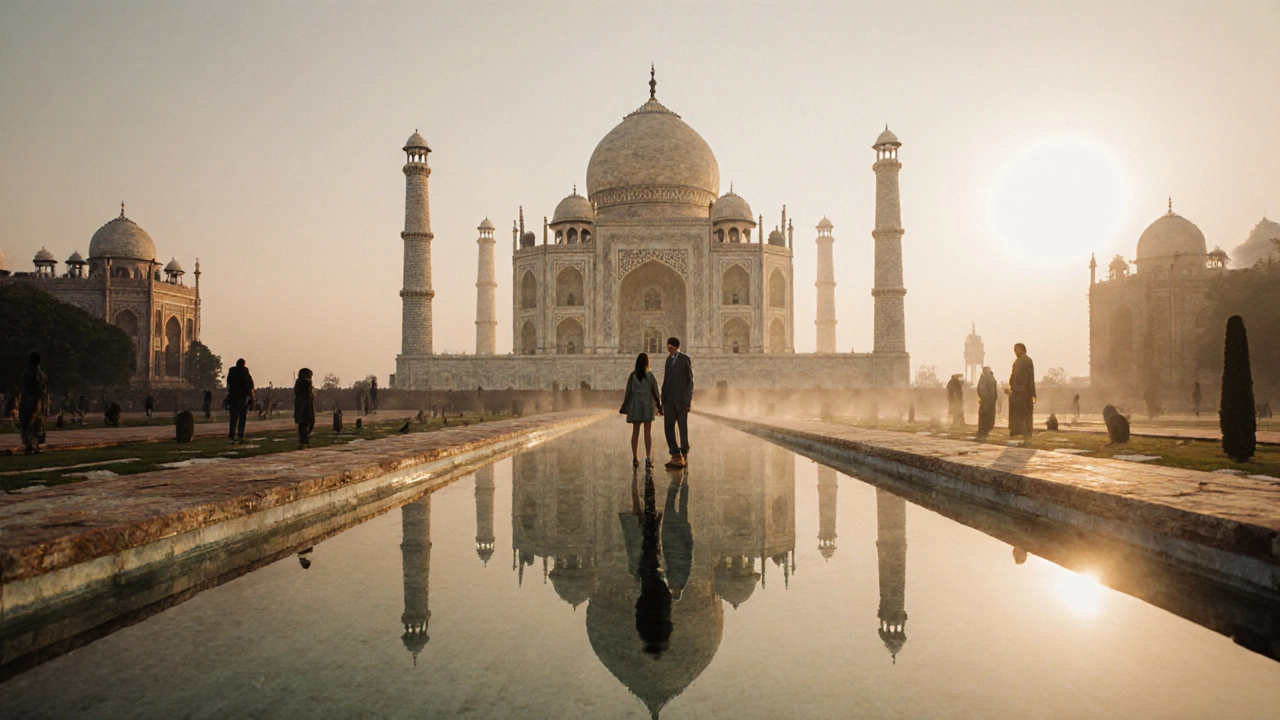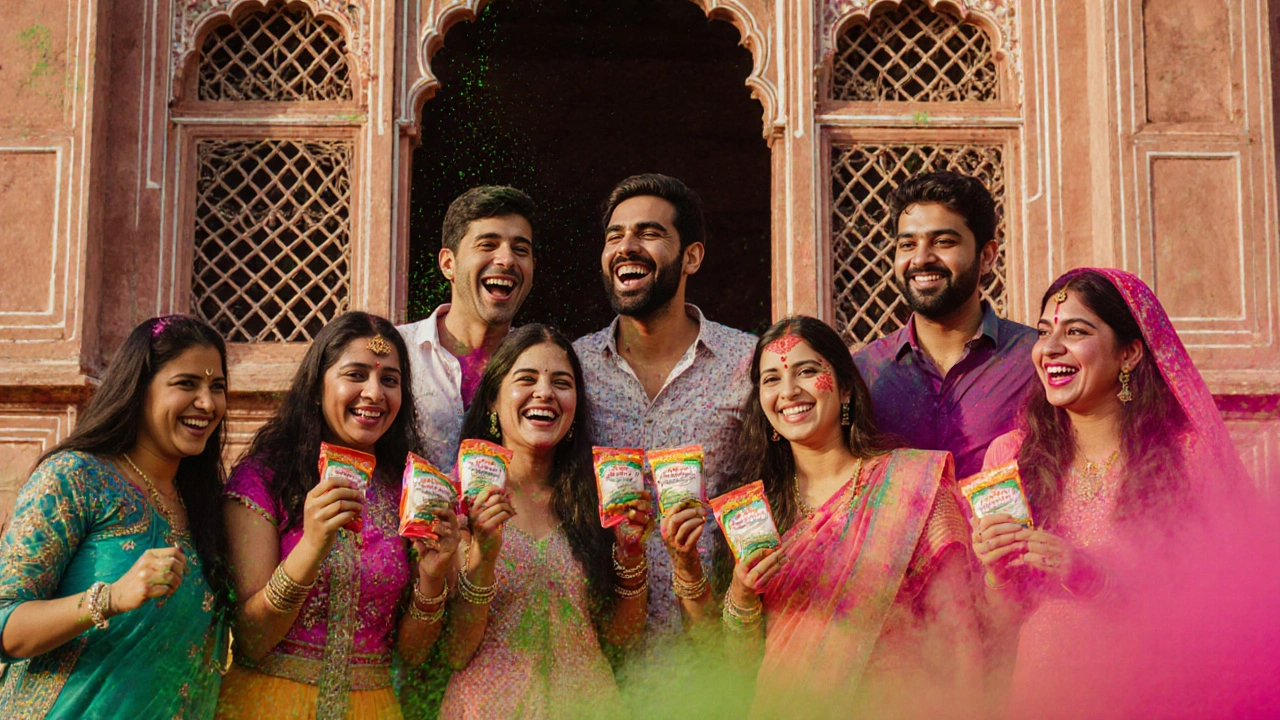Which Part of India Is Most Visited by Foreigners? The Top Destination Revealed

- Nov, 20 2025
- 0 Comments
- Aaron Blackwood
India Tourist Destination Calculator
Tourist Distribution Calculator
Based on 2024 Ministry of Tourism data, over 68% of foreign tourists visit North India (including the Golden Triangle). Input total visitors to see regional breakdown.
Regional Breakdown
Golden Triangle Details
The Golden Triangle (Delhi, Agra, Jaipur) accounts for 45% of total tourists.
What's happening in North India?
North India attracts 68% of all foreign tourists due to the Golden Triangle, better infrastructure, and globally recognized landmarks like the Taj Mahal (7M+ annual visitors).
The Golden Triangle (Delhi, Agra, Jaipur) is the most popular tourist circuit with over 45% of all foreign visitors. Most arrive through Delhi's international airport.
Every year, over 10 million foreign tourists step off planes and trains into India. But not all of them go to the same place. If you walk through the streets of Delhi, Agra, or Jaipur in peak season, you’ll hear a dozen languages spoken in the same minute. English, French, Russian, German, Japanese, Spanish - they all blend into the noise of rickshaws, temple bells, and street vendors calling out for chai. The truth is simple: North India draws the most foreign visitors by a wide margin.
Why North India? It’s Not Just the Taj Mahal
People think it’s just the Taj Mahal. And yes, the Taj alone gets over 7 million visitors a year - more than the Eiffel Tower or the Colosseum. But that’s only the start. Foreign tourists don’t come for one monument. They come for a chain of experiences that only North India can offer.The Golden Triangle - Delhi, Agra, Jaipur - is the most popular tourist circuit in the country. It’s not a secret route. It’s the default. Airlines, tour operators, and travel agencies all bundle these three cities together because they know it works. Delhi gives you history with a modern edge: the Red Fort, Humayun’s Tomb, and bustling Chandni Chowk. Agra delivers the Taj, sure, but also the Agra Fort, where Mughal emperors lived and died. Jaipur adds color, crafts, and royal palaces - the City of Pink, where every alley has a story carved in stone.
These cities aren’t just attractions. They’re entry points. Most foreigners arrive in Delhi. They spend a day or two getting used to the noise, the smells, the pace. Then they hop on a train or book a private car to Agra. After the Taj, they drive to Jaipur. By the time they leave, they’ve seen palaces, temples, bazaars, and desert forts - all in under a week. That’s the magic. North India packs the most iconic sights into the shortest time.
What About the Rest of India?
South India has temples that are older, beaches that are quieter, and food that’s spicier. Kerala’s backwaters and Goa’s beaches draw crowds too. But the numbers don’t lie. In 2024, the Ministry of Tourism reported that 68% of all foreign tourists entered India through the northern corridor. Only 17% focused on the south. The rest split between the west (Rajasthan, Gujarat) and the east (Bengal, Varanasi).Why the gap? For many, India is their first trip to Asia. They want the postcard version - the grandeur, the romance, the history they’ve seen in movies. North India delivers that instantly. The Taj Mahal is a visual shorthand for India around the world. It’s the first thing Google shows when you type “India travel.” That kind of recognition drives traffic.
Also, infrastructure matters. North India has better international flight links. Delhi’s Indira Gandhi Airport handles more foreign arrivals than Mumbai, Bengaluru, or Chennai combined. Trains between Delhi, Agra, and Jaipur are frequent, clean, and affordable. Tourist-friendly hotels, English-speaking guides, and organized day tours are everywhere. In contrast, getting to Hampi or Mysore from a foreign airport often requires multiple connections and longer travel times.
The Real Drivers: Culture, History, and Accessibility
It’s not just about convenience. North India offers a concentrated dose of what most foreigners imagine when they think of India: Mughal architecture, Rajput forts, sacred rivers, and vibrant festivals.Varanasi, on the Ganges, is the spiritual heart of the country. Foreigners come to witness the evening aarti ceremony - hundreds of oil lamps floating on the river, chants echoing under the stars. Many say it’s the most moving experience of their lives. Then there’s Rishikesh, where yoga and meditation draw tens of thousands each year. Beatles fans still pilgrimage to the ashram where the band meditated in the 1960s.
And let’s not forget the festivals. Holi in Mathura and Vrindavan turns entire towns into color explosions. Diwali in Jaipur turns palaces into glittering lanterns. These aren’t staged shows. They’re real, living traditions. Foreigners don’t just watch - they join. They smear each other with pink and green powder. They light diyas. They eat sweets from strangers. That immersion is rare in other parts of the world.
Who’s Coming and Why?
The top five source countries for foreign tourists to North India are the United States, the United Kingdom, Australia, Germany, and Russia. Each group has different reasons.Americans and Brits come for history and heritage. They book guided tours of forts and palaces. They spend hours in museums. They read books about the Mughals before they even land.
Australians and Germans tend to be more adventurous. They combine the Golden Triangle with a trek in the Himalayas or a visit to the Thar Desert. Many rent scooters and drive from Jaipur to Jodhpur on their own.
Russians love the spiritual side. Varanasi and Rishikesh are huge with them. Some stay for months, studying yoga or learning Sanskrit. There’s even a Russian-language yoga school in Rishikesh that’s been running for over 20 years.
And then there are the honeymooners. North India is the top choice for couples from Europe and North America. The Taj Mahal isn’t just a monument - it’s a symbol of love. Many propose there. Others book luxury heritage hotels in Udaipur or Jaisalmer for their stay. The romantic imagery sells.
What’s Changing? The New Trends
In 2025, something new is happening. More tourists are skipping Delhi and going straight to Rajasthan. They’re avoiding the chaos of the capital and heading to Jodhpur’s blue houses, Jaisalmer’s golden fort, or the desert camps of Bikaner. They want authenticity over convenience.Also, solo travelers - especially women - are choosing North India more than ever. Safe, well-marked routes, women-only tour groups, and guesthouses with female managers are making it easier. Many now stay in restored havelis (traditional mansions) that have been turned into boutique hotels. These places offer privacy, comfort, and local charm.
And then there’s the food. North Indian cuisine - butter chicken, naan, kebabs, paneer tikka - is the most familiar to foreigners. It’s less intimidating than the complex spice blends of the south. Many first-time visitors start with dal makhani and garlic naan. That comfort food becomes their gateway to exploring more.

Is North India Overcrowded?
Yes. The Taj Mahal gets so packed that visitors now have to book timed entry slots. Agra’s streets are lined with touts offering fake guides and cheap souvenirs. Jaipur’s markets can be overwhelming.But that’s not a reason to avoid it. It’s a reason to plan smarter. Go in October or March - not January or July. Book hotels and train tickets early. Hire a local guide who knows the quiet corners. Skip the main entrance at the Taj and go through the back gate at sunrise. You’ll have the monument to yourself for 20 minutes. That’s the secret most tourists never learn.
North India isn’t perfect. But it’s the most complete introduction to the country. You get palaces, temples, deserts, mountains, rivers, food, festivals, and history - all within a few hundred kilometers. No other region offers that density.
What’s Next for Foreign Tourists?
The government is pushing for more offbeat routes. Places like Mandawa, Bundi, and Chittorgarh are getting better infrastructure. More foreigners are starting to explore them. But for now, the Golden Triangle remains the anchor. It’s the first stop. The gateway. The place where most people fall in love with India.If you’re planning your first trip to India, start here. Don’t wait for the perfect time. Don’t wait until you’ve read every book. Just go. The Taj will wait. The chai will be hot. And the noise? It’ll become part of the memory you never expected to have.
Is the Taj Mahal the most visited site in India by foreigners?
Yes, the Taj Mahal is the single most visited site by foreign tourists in India, with over 7 million visitors annually. It’s the main reason most international travelers include North India in their itinerary. While other sites like the Red Fort and Amber Fort also draw large crowds, none come close to the Taj’s global recognition and visitor numbers.
Which cities make up the Golden Triangle?
The Golden Triangle consists of Delhi, Agra, and Jaipur. These three cities form a triangle on the map, connected by well-maintained roads and frequent trains. It’s the most popular tourist route in India because it offers the highest concentration of iconic landmarks - from Mughal architecture in Agra to royal palaces in Jaipur and ancient forts in Delhi - all within a 3- to 5-day trip.
Why do more foreigners visit North India than South India?
North India has better international flight access, especially through Delhi’s airport, which handles more foreign arrivals than any other Indian city. The region also offers a compact cluster of globally famous landmarks - the Taj Mahal, Red Fort, Amber Fort - that match what most tourists expect from India. South India has deeper cultural roots and stunning temples, but they’re more spread out and harder to reach without multiple flights or long drives.
Are there safe options for solo female travelers in North India?
Yes. Many women now travel solo in North India, especially on the Golden Triangle route. Cities like Jaipur, Udaipur, and Rishikesh have a growing number of women-only guesthouses, female-led tour groups, and hotels with 24/7 security. Staying in heritage properties with local owners also helps - these places often provide personal guidance and are more aware of safety concerns. Planning ahead and avoiding isolated areas at night makes the experience smooth and safe.
When is the best time to visit North India to avoid crowds?
The best times are October to November and February to March. These months have mild weather and fewer tourists compared to peak season (December-January) and the monsoon (July-August). Booking tickets early and visiting major sites at sunrise helps avoid the busiest hours. For example, entering the Taj Mahal at 6 a.m. gives you quiet access before the crowds arrive.
Do most foreign tourists stay only in the Golden Triangle?
Most first-time visitors stick to the Golden Triangle because it’s efficient and covers the highlights. But a growing number are extending their trips to include Varanasi, Rishikesh, or even the Himalayan hill stations like Shimla and Manali. These add spiritual, cultural, or adventurous layers to the journey. Still, over 70% of foreign tourists spend at least 70% of their time in Delhi, Agra, and Jaipur.